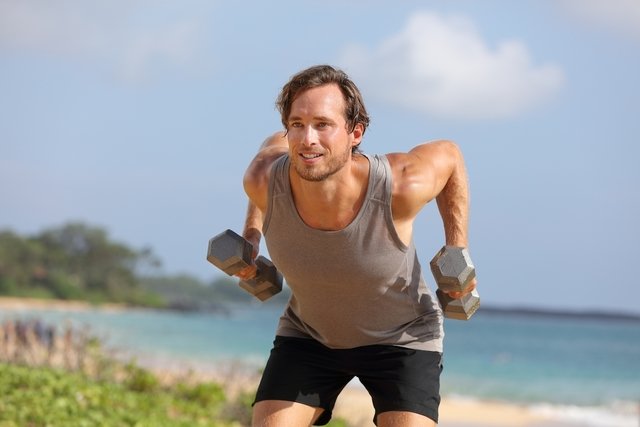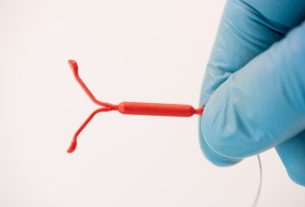Back training at home can be done to improve posture, strengthen muscles, increase definition or even generate hypertrophy. These exercises work all the back muscles, such as the rhomboid, trapezius and round muscles, but they also strengthen muscles in other areas, especially the deltoid, biceps, triceps and abdomen.
Training at home can be done without weights, but for those who want to increase the intensity of the exercises, it is recommended to use weights, which can be a plastic bottle with sand or water, backpacks with a packet of rice or simply dumbbells. Another option is to use an elastic band, for example.
Before starting training, it is important to have a medical consultation to assess your physical condition and receive guidance from a physical educator who must indicate the weight for each exercise individually.
How to do the back workout
Back training at home can be done 2 to 3 times a week, in 2 to 3 sets of 10 to 15 repetitions, depending on the exercise. The ideal is to choose 3 to 4 exercises per workout.
It is important to warm up before exercising, and it is a good option to move your arms up and down alternately, and to the sides, several times and at a fast pace, for example.
Back Workout Options
Some exercise options to do a complete back workout at home are:
1. Bent over row

The bent-over row is an excellent exercise option for the back, as it works the upper back muscles, as well as the deltoids, trapezius and biceps, improving muscular strength and endurance as well as posture. This exercise must be done using weight. Discover other types of paddling.
How to make: Standing, with your legs shoulder-width apart and your legs slightly bent, lean your torso forward. Your arms should be aligned with your body and your hands should be facing inwards, holding a weight in each hand. It is important that your back is straight and your abdomen is contracted.
Pull the weight upwards, flexing your arms. Slowly lower your arms towards the floor, stretching them completely. With each movement of the arms, you should inhale when the arms are straight and exhale when they are flexed. Do 2 to 3 sets of 12 repetitions and rest 1 minute between sets.
2. Leaning Inverted Crucifix

This exercise works to strengthen and define or hypertrophy the back muscles such as the rhomboid, trapezius and teres, in addition to the shoulder, chest and abdominal muscles. This exercise must be done using weights or an elastic band.
How to make: Standing with your feet shoulder-width apart and your arms at your sides, hold a weight in each hand. With your abdomen contracted and your back straight, lean your torso forward. Raise your arms to the sides without bending your elbows and with your palms facing down, until they are at shoulder level. Lower your arms slowly, returning to the starting position. It is important to inhale when your arms are down and exhale when you raise your arms.
If you use an elastic band, the exercise position is the same, however, you must place the elastic band on the floor, step in the middle of the band with both feet and grab each end of the elastic band with your hands. Raise your arms slowly by pulling the band upwards and then lower your arms again. Repeat the arm movement 10 to 15 times in 2 to 3 sets.
3. Arm raises

The arm raise exercise allows you to strengthen and develop the muscles in the upper back, such as the trapezius and rhomboid, as well as the arms, shoulders and chest, making it a good option for people who want back and shoulder hypertrophy. This exercise must be done using weight.
How to make: Sit on a bench or chair and place the weights so that your upper arm and forearm form a 90-degree angle. It is important that your palms face forward, your back is always straight and your abdomen is contracted. Lift the weights until your arms are straight and return to the starting position.
4. Incline push-up

The incline push-up works several muscle groups, including the back, triceps, chest and abdomen, which allows you to strengthen and define your back muscles. This exercise does not require weights and must be done using a surface to create an inclination of the body, such as a Kettle, stool or chair, for example.
How to make: With your arms stretched out in front of your body, place your hands on the surface, at a distance slightly greater than shoulder width. Keep your feet on the floor, legs stretched and spine straight. Contract your abdomen and flex your elbows until your chest touches the surface and returns to the starting position. You can do 2 to 3 sets of 8 to 15 repetitions each, resting for 60 to 90 seconds between sets.
5. Superman

The exercise of superman simulates the superman flying position and works to strengthen the lumbar region of the back, as well as the muscles of the abdomen, glutes, hips, hamstrings and shoulders, improving posture and flexibility. To do this exercise, it is not necessary to use weights.
How to make: lie on the floor face down, with your legs stretched out, arms extended above your head and palms facing down. Contract your abs, glutes and lumbar spine. Raise your arms and legs back, as if you were going to fly. It is important that the head is aligned with the spine and, therefore, it is important to keep your eyes on the floor. Furthermore, the elevation of the legs and arms should not exceed 20 cm from the floor. Hold this position for 2 to 5 seconds and return to the starting position. Repeat this movement for 1 minute.
6. Plank

Although the plank is an exercise more focused on strengthening the abdominal and core muscles, it is also considered a complete exercise, that is, it works other areas of the body, including the back. There is no need to use weights for this exercise.
How to make: lie on your stomach and then raise your body, resting only your forearms and toes on the floor, always with your abdomen and glutes contracted and your head and body straight, aligned with your spine. You should stay still in this position for as long as possible. You can start with 30 seconds and gradually increase the time. This exercise is not done in sets.
What to do after training
After back training, you should do stretches to help relax your muscles, tone your muscles, improve flexibility, increase circulation and prevent injuries.
Some stretching options include:
1. Sit on your heels

This stretch allows you to stretch the back muscles such as the trapezius, rhomboid and teres, in addition to the deltoids, pectorals and spine, and must be done sitting down.
How to make: get on your knees on the floor and place your buttocks on your heels, as if you were going to sit down. Lean your torso forward, bringing it closer to the floor, keeping your arms straight and your palms facing down. Do this movement for 30 to 60 seconds.
2. Lateral flexion of the trunk

Lateral flexion of the trunk stretches the back muscles, as well as the torso and hips and must be done standing up.
How to make: Standing, with your feet shoulder-width apart, raise your arms upwards, keeping them extended and joining one hand to the other. Tilt your body to one side, as much as you can, and return to the starting position and tilt to the other side. Do this movement for 30 times on each side.

Sign up for our newsletter and stay up to date with exclusive news
that can transform your routine!
Warning: Undefined array key "title" in /home/storelat/public_html/wp-content/plugins/link-whisper-premium/templates/frontend/related-posts.php on line 12
Warning: Undefined array key "title_tag" in /home/storelat/public_html/wp-content/plugins/link-whisper-premium/templates/frontend/related-posts.php on line 13



